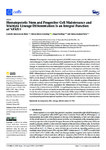Hematopoietic Stem and Progenitor Cell Maintenance and Multiple Lineage Differentiation Is an Integral Function of NFATc1
| dc.contributor.author | Barahona de Brito, C | |
| dc.contributor.author | Klein-Hessling, S | |
| dc.contributor.author | Serfling, E | |
| dc.contributor.author | Patra, AK | |
| dc.date.accessioned | 2022-07-22T08:18:29Z | |
| dc.date.issued | 2022-06-23 | |
| dc.identifier.issn | 2073-4409 | |
| dc.identifier.issn | 2073-4409 | |
| dc.identifier.other | 2012 | |
| dc.identifier.uri | http://hdl.handle.net/10026.1/19431 | |
| dc.description.abstract |
<jats:p>Hematopoietic stem and progenitor cell (HSPC) maintenance and the differentiation of various lineages is a highly complex but precisely regulated process. Multiple signaling pathways and an array of transcription factors influence HSPC maintenance and the differentiation of individual lineages to constitute a functional hematopoietic system. Nuclear factor of activated T cell (NFAT) family transcription factors have been studied in the context of development and function of multiple mature hematopoietic lineage cells. However, until now their contribution in HSPC physiology and HSPC differentiation to multiple hematopoietic lineages has remained poorly understood. Here, we show that NFAT proteins, specifically NFATc1, play an indispensable role in the maintenance of HSPCs. In the absence of NFATc1, very few HSPCs develop in the bone marrow, which are functionally defective. In addition to HSPC maintenance, NFATc1 also critically regulates differentiation of lymphoid, myeloid, and erythroid lineage cells from HSPCs. Deficiency of NFATc1 strongly impaired, while enhanced NFATc1 activity augmented, the differentiation of these lineages, which further attested to the vital involvement of NFATc1 in regulating hematopoiesis. Hematopoietic defects due to lack of NFATc1 activity can lead to severe pathologies such as lymphopenia, myelopenia, and a drastically reduced lifespan underlining the critical role NFATc1 plays in HSPC maintenance and in the differentaion of various lineages. Our findings suggest that NFATc1 is a critical component of the myriad signaling and transcriptional regulators that are essential to maintain normal hematopoiesis.</jats:p> | |
| dc.format.extent | 2012-2012 | |
| dc.format.medium | Electronic | |
| dc.language | en | |
| dc.language.iso | eng | |
| dc.publisher | MDPI | |
| dc.subject | hematopoiesis | |
| dc.subject | HSC | |
| dc.subject | lineage differentiation | |
| dc.subject | NFATc1 | |
| dc.title | Hematopoietic Stem and Progenitor Cell Maintenance and Multiple Lineage Differentiation Is an Integral Function of NFATc1 | |
| dc.type | journal-article | |
| dc.type | Journal Article | |
| dc.type | Research Support, Non-U.S. Gov't | |
| plymouth.author-url | https://www.webofscience.com/api/gateway?GWVersion=2&SrcApp=PARTNER_APP&SrcAuth=LinksAMR&KeyUT=WOS:000825662600001&DestLinkType=FullRecord&DestApp=ALL_WOS&UsrCustomerID=11bb513d99f797142bcfeffcc58ea008 | |
| plymouth.issue | 13 | |
| plymouth.volume | 11 | |
| plymouth.publication-status | Published online | |
| plymouth.journal | Cells | |
| dc.identifier.doi | 10.3390/cells11132012 | |
| plymouth.organisational-group | /Plymouth | |
| plymouth.organisational-group | /Plymouth/Faculty of Health | |
| plymouth.organisational-group | /Plymouth/Faculty of Health/Peninsula Medical School | |
| plymouth.organisational-group | /Plymouth/REF 2021 Researchers by UoA | |
| plymouth.organisational-group | /Plymouth/REF 2021 Researchers by UoA/UoA01 Clinical Medicine | |
| plymouth.organisational-group | /Plymouth/Users by role | |
| plymouth.organisational-group | /Plymouth/Users by role/Academics | |
| dc.publisher.place | Switzerland | |
| dcterms.dateAccepted | 2021-06-21 | |
| dc.rights.embargodate | 2022-7-23 | |
| dc.identifier.eissn | 2073-4409 | |
| dc.rights.embargoperiod | Not known | |
| rioxxterms.versionofrecord | 10.3390/cells11132012 | |
| rioxxterms.licenseref.uri | http://www.rioxx.net/licenses/all-rights-reserved | |
| rioxxterms.licenseref.startdate | 2022-06-23 | |
| rioxxterms.type | Journal Article/Review |


